Nuno Vitorino and Amelia Santos, a husband-and-wife team, founded Innuos in 2013. Based in Portugal, you can read more of their story in our interview with Amelia.
The PhoeixNET adds something a little different to their main product line. To start with, it has one input and three outputs. There is no display, not even a front or rear LED to tell that you it’s turned on. It has a rear-mounted on/off switch, but the only way to tell that it is on and doing something is to look at the device it’s connected to. Nuno thinks all LEDs add noise, but this solution might be taking things to an extreme.
However, I can’t hardly argue with the results.
Will the PhoenixNET Make a Difference?
I have always connected my Innuos Statement directly to the router. I asked several people I know who are computer experts if there would be a difference in the sound if I put the switch between the router and my Statement. They said that there would be no difference at all. Then I asked a friend who was both an audiophile and a computer expert, and he said he wasn’t sure but he didn’t expect it would make much difference. So, I have to admit that I went into this review expecting to hear very little difference if any at all.
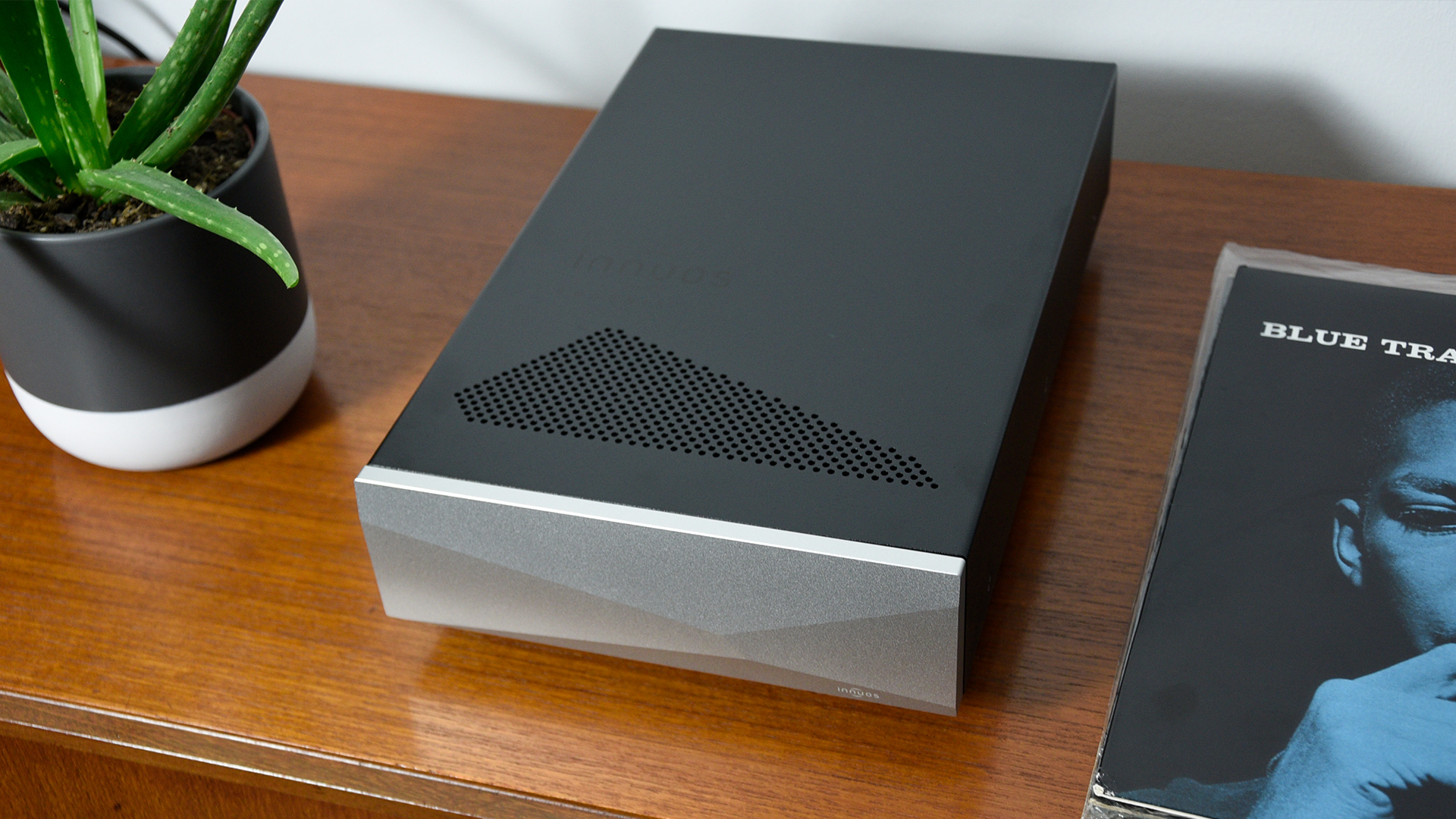
Here’s What Innuos Says
Innuos describes the PhoenixNET as a Network Switch. They say it is, “the realization of Innuos’ philosophy of simplicity and signal purity applied to the network switch…” When designing the PhoenixNET, Innuos identified four key areas on which they concentrated their efforts. These four areas are copied here from the Innuos website:
- Minimise Network Switch Noise – no internal switching regulators and 3 independent voltages supplied by Statement* grade linear power supply. Individual network isolation transformers, high quality ethernet ports (1 in and 3 out), managed EMI absorption.
- Increase Clocking Precision and Stability – Using the same OCXO clocks as used in the Statement, individually powered.
- Provide Pristine Power to the Components – two independent Statement grade linear power supplies with Mundorf Caps.
- Minimise Vibration on Components – three levels of vibration control via the anti-vibration feet, top cover treatment and silicon mounted ports.
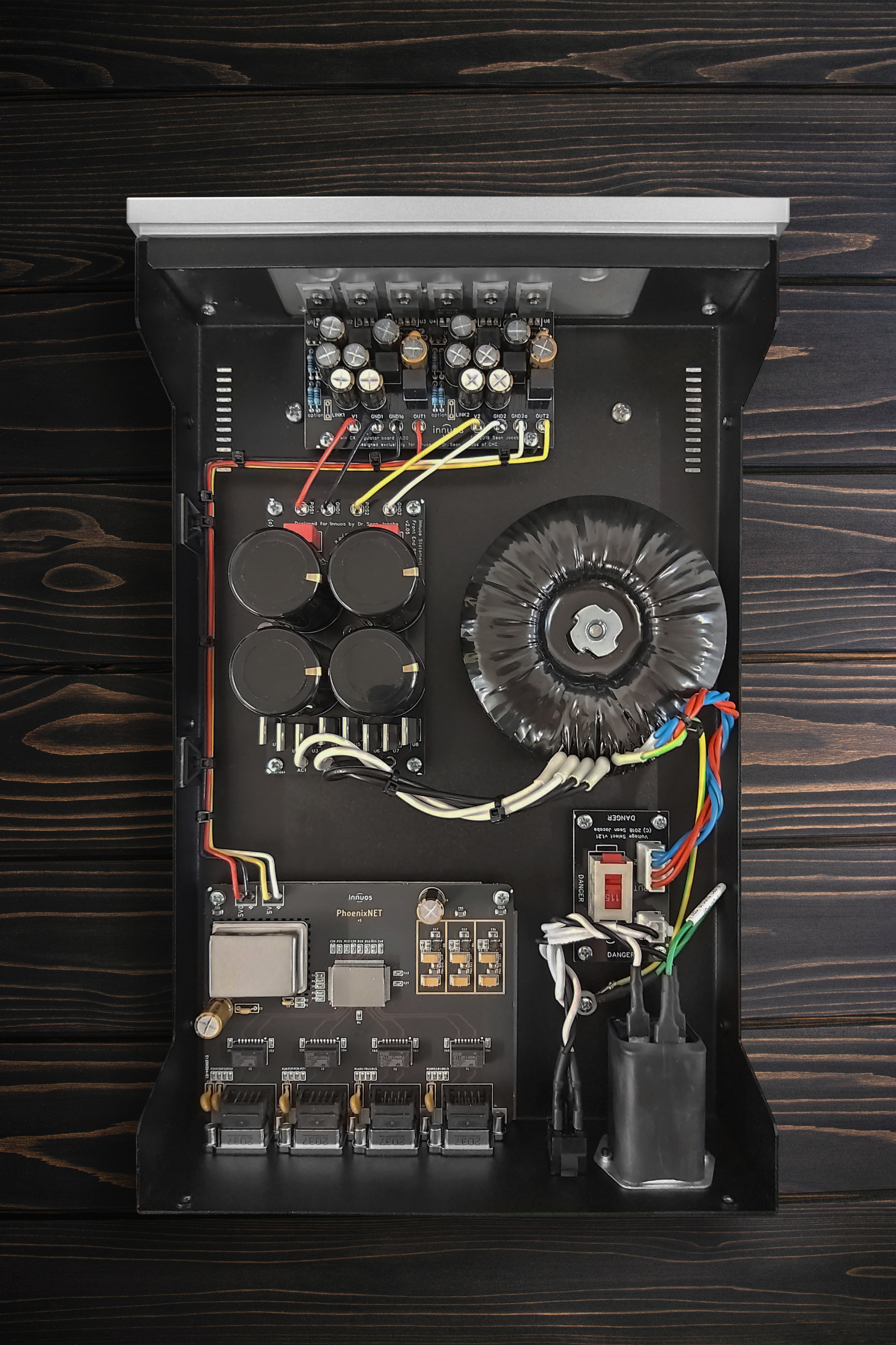
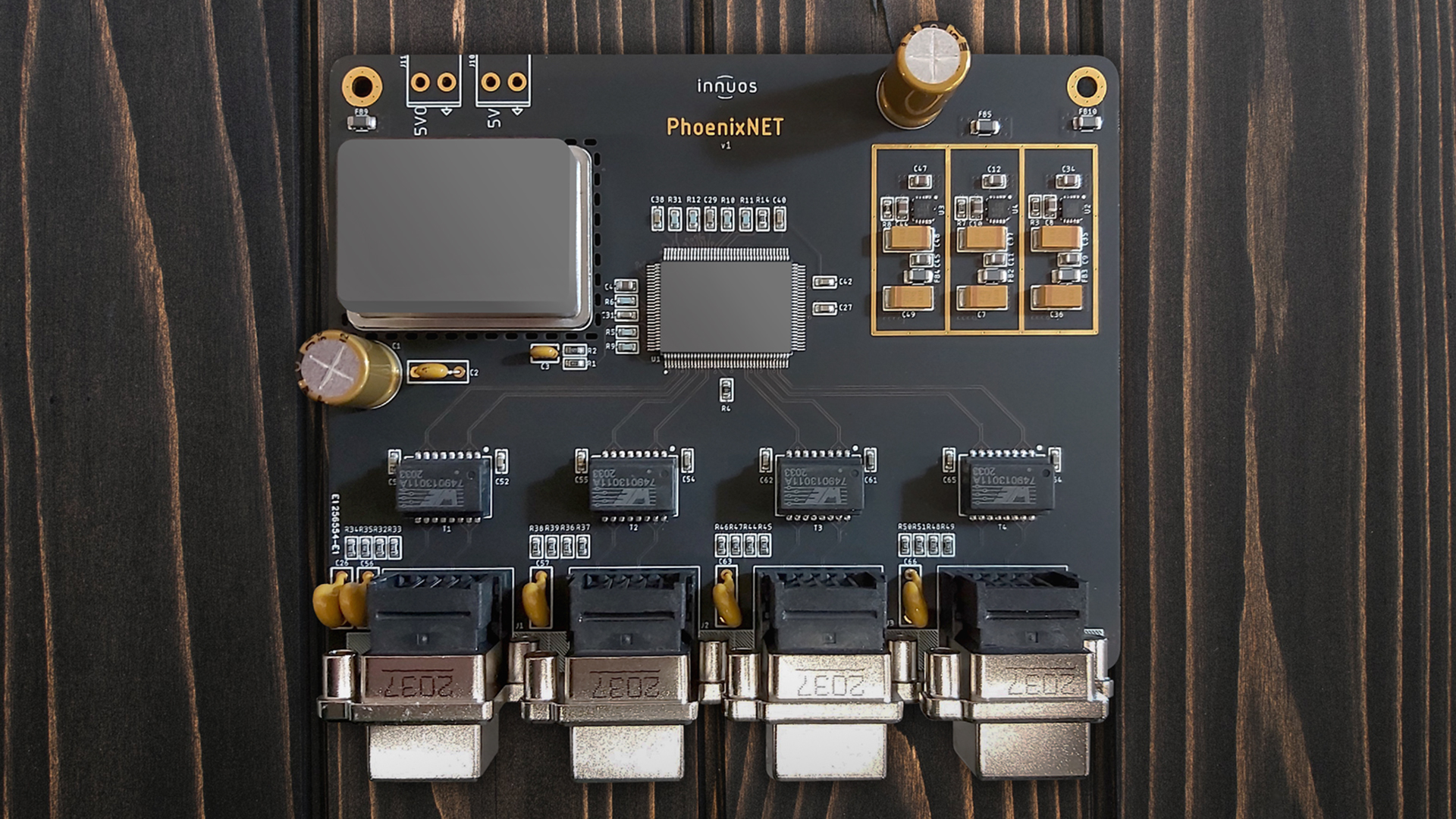
Could I Hear a Difference?
The answer is an emphatic yes. So, did this difference improve the sound? I used a trial-and-error method to get my answer. When I first listened, I used the power cord that came with the PhoenixNET plugged into the wall. I placed the unit next to my Statement, detached the ethernet cord from it, and plugged that cord into the input of the PhoenixNET. Then I ran the cord that came with the PhoenixNet between the two units. Now, I was ready to listen. With this setup, I could easily hear a difference, but the difference was not always better.
Next, I put an Audience AU24 power cord into the PhoenixNet and plugged it into my HB Cable PowerSlave Marble Power Distributor. In this setup, the difference was much more obvious and much better.
Then I replaced the stock ethernet cable with an Audience ethernet cable. The sound after this change surprised me as it was a significant step forward. So, I decided to sit down and make some comparisons. With both the stock ethernet cable and the Audience ethernet cable, I did notice a mid-base bump in my system right out of the box. With both cables, this bump went away after about six hours of use.
Comparison One: With and Without the PhoenixNET
The most obvious thing I heard at first was a much cleaner and more pristine treble region. The next difference I heard was an overall sense of solidity. The soundstage was also more three-dimensional and the instruments and voices were more solid. Regardless of whether I played classical music, jazz, rock, bluegrass or vocals, the PhoenixNET produced a sound that was much closer to live music.
I watched a video online and heard a dealer say that the PhoenixNET made the music sound more analog. I would agree if he meant that it sounded more like tape, but I wouldn’t agree that it makes the music sound more like vinyl. The lack of haze, the solidity and the overall tonal correctness remind me so much of listening to a good tape recording.
Comparison Two: PhoenixNET vs. a Solid-State Drive
If my results from Comparison One were hard to believe, what I heard in Comparison Two simply didn’t make sense to me. I listened to album after album streamed from Qobuz through the PhoenixNET and compared what I heard when I to listened to the same albums played from the Statement hard drive. I was shocked that I always preferred the streaming version with the PhoenixNET.
I found it so hard to believe what I was hearing that one night I asked Becky to come in and listen to Dolly Parton‘s Little Sparrow album with me as it is one of her favorites. I started by playing “Sweet By and By”. When the song was over, I asked her to play reviewer for a minute. I changed a couple of cables and started the song again. I’m not kidding here, less than 15 seconds into the song she said it sounded way better. I asked her what she meant. She still doesn’t use audiophile terms often but said, “It doesn’t sound shrill at all and Dolly’s voice sounds so much better.” Then I told her that I had added the PhoenixNET into the system. She said, “Well, I guess we’ll just have to buy that little silver box.” Note, the sample I reviewed was silver.
I have no idea why this little box makes such a difference, but I had the PhoenixNET in my system for more than two months, and I only found two CD-quality albums that sounded better on the hard drive.
Comparison Three: PhoenixNET vs. Hi-Rez Files
I did not expect the PhoenixNET to outperform Hi-Rez files, and it didn’t. Still, I found them to be very close. In fact, the only Hi-Rez files I would be willing to pay up to $50 for would-be DSD files or albums that are not available to stream. This makes the value of the PhoenixNET a whole new ballgame. I wouldn’t have to purchase downloads and could free up hard drive space. Then the PhoenixNET potentially becomes a money-saving investment. You could, for example, recoup a good bit of the price of the PhoenixNET by purchasing less than 100 Hi-Rez downloads.
Who Needs a PhoenixNET?
The smart-aleck answer is anyone who has a digital source should consider purchasing a PhoenixNet. Yes, you need a digital source, but the real answer is a little more complicated. If you have a digital source and it costs less than the price of the PhoenixNet, you would be better off upgrading your digital source first. Also, if you haven’t yet invested in good power cords and a good power distributor or conditioner you need to do that before you get the PhoenixNet.
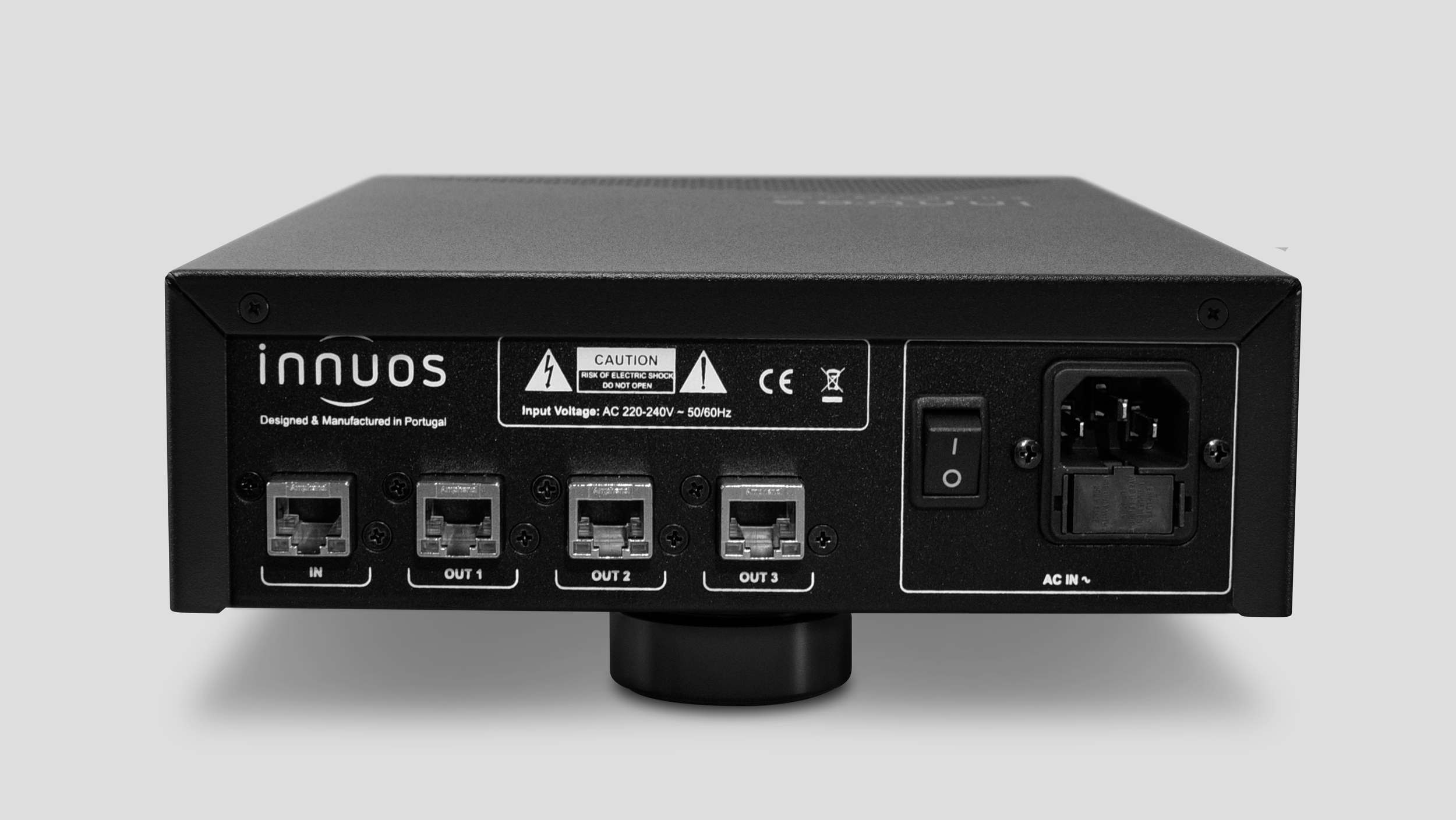
Conclusion
Let me start my conclusion by saying that before I had the PhoenixNET in my system, I listened to streaming music about 20% of the time and digital downloads the rest of the time. With the PhoenixNET, this ratio has completely flipped. I also have not purchased a single download since putting the PhoenixNET in my system.
This change in my listening habits may make the PhoenixNET the most significant product that I got in to review in 2021. Not only did it make a huge difference in the sound of music that I streamed, it also has the long-term potential to save me a lot of money that I would have spent on digital downloads. As I said earlier in this review, I don’t plan to purchase any digital downloads that I can stream except for maybe a few DSD downloads.
Summing up, I highly recommend the PhoenixNET for those of you who have a really good digital system even though I have no idea why it works.
Innous Website
Price: US $3149

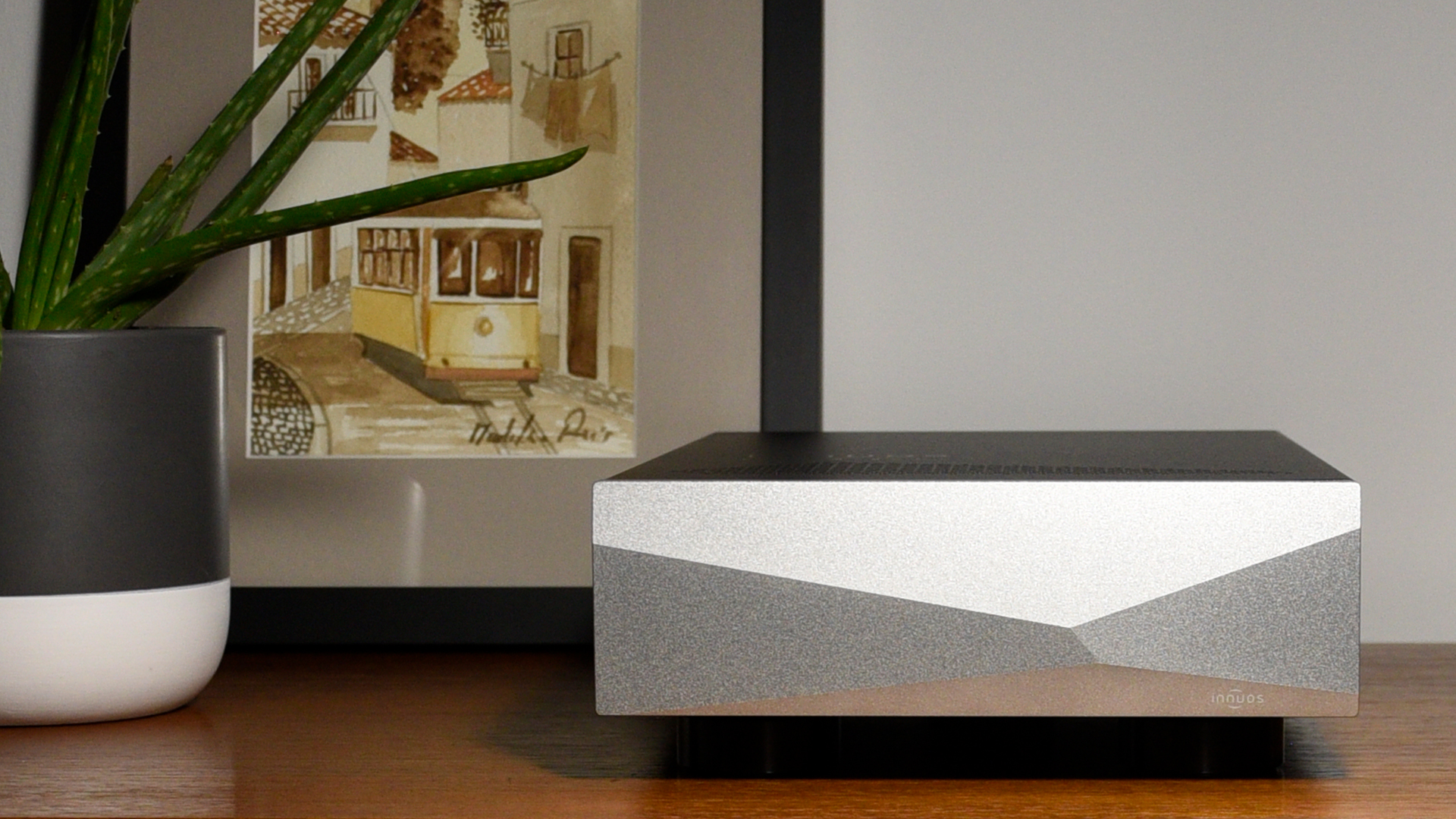
The PhoenixNet transformed my listening as well. I had been missing a lot of music streaming Qobuz through a ZENith Mk3/PhoenixUSB/MScaler/DAVE/Focal Utopia.